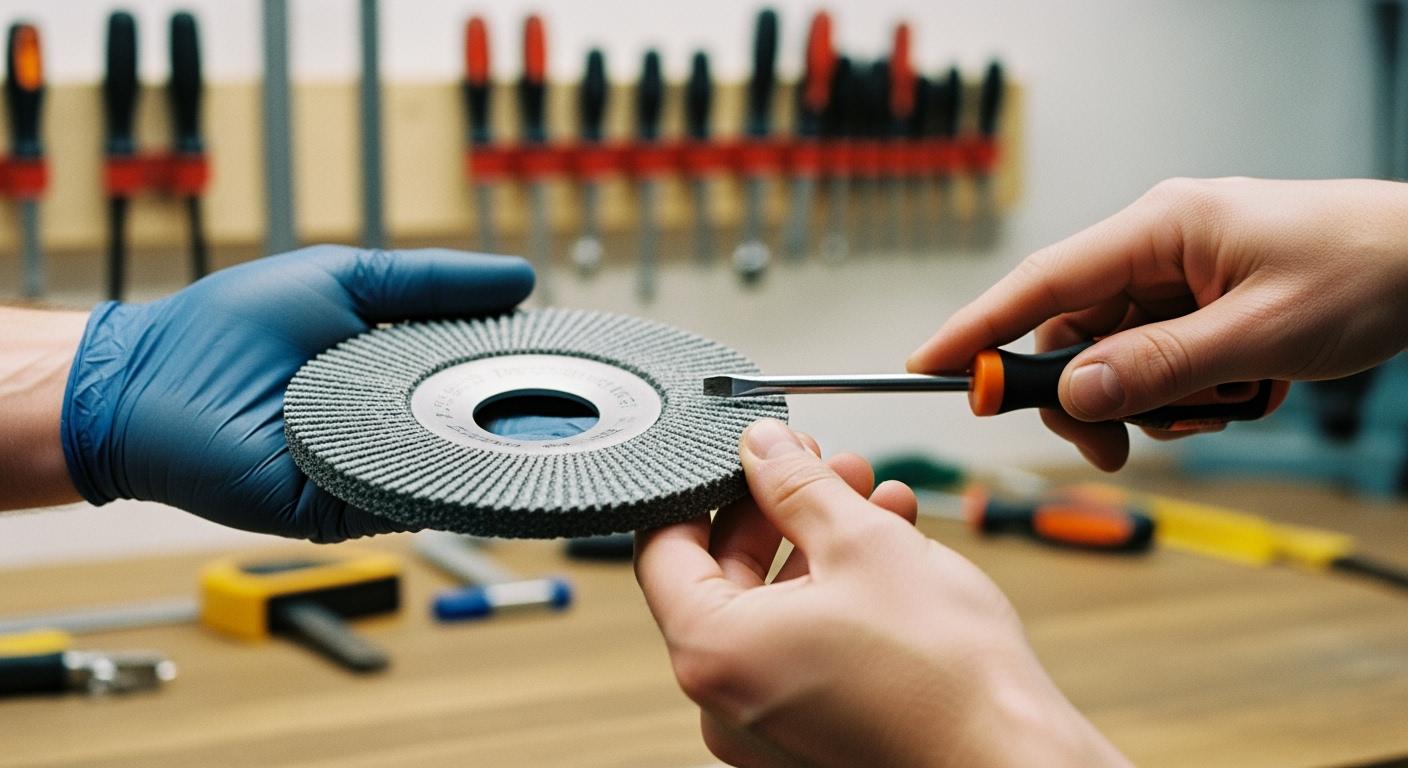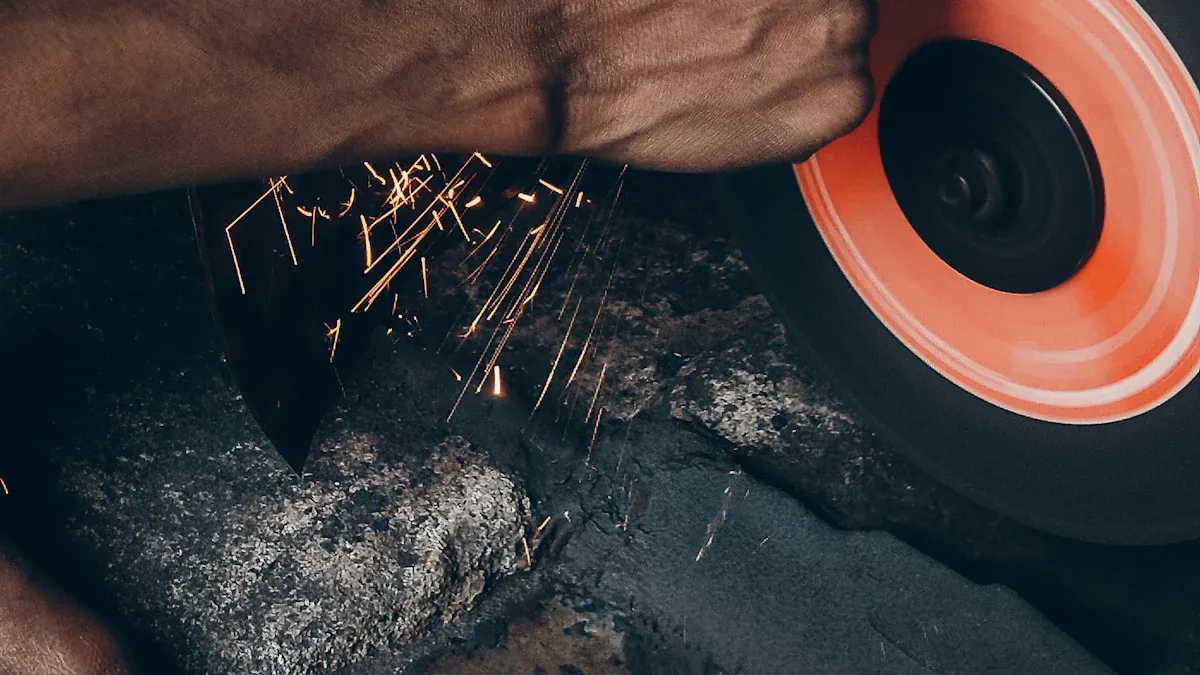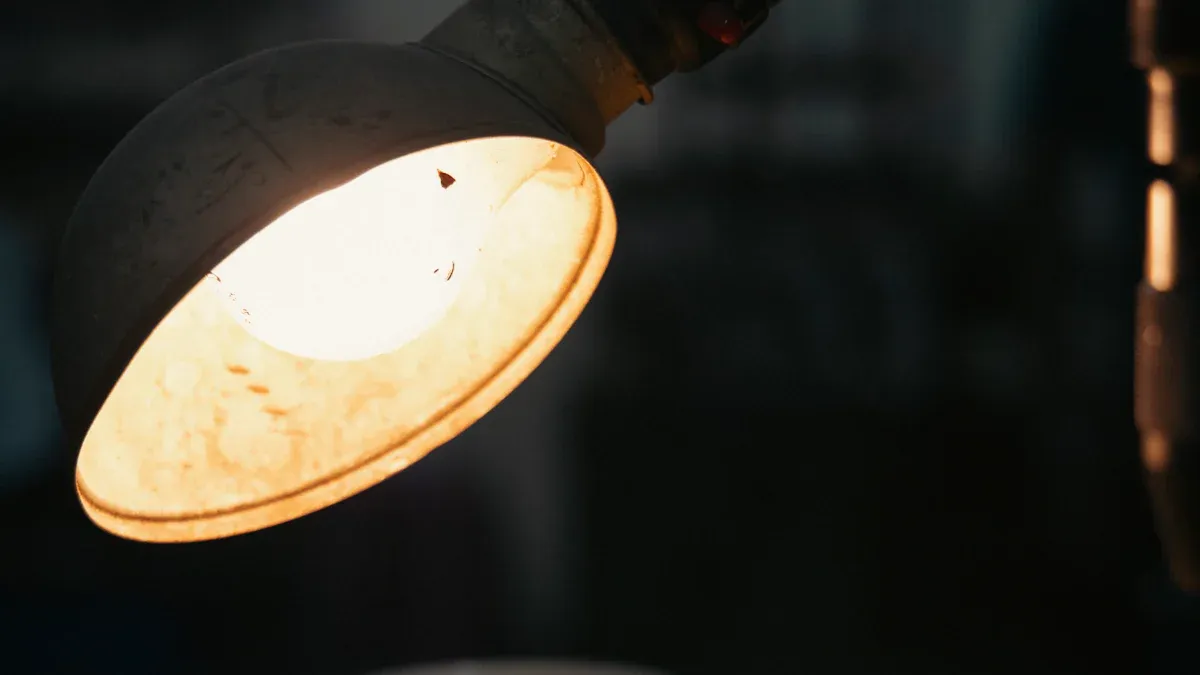
Checking your grinding wheel is the most important safety step before you power on a grinder. Shockingly, thousands of injuries occur each year from grinder accidents.
Did You Know? ⚠️
- Over 5,400 injuries are reported annually from angle grinder use.
- A large number of these are caused by a shattering abrasive wheel.
To ensure good grinding wheel quality, you must perform two simple checks. A quick visual inspection and the “ring test” are essential. These methods help you find a hidden crack or defect that could cause a grinding wheel to break apart during use.
Key Takeaways
- Always do a visual check of your grinding wheel. Look for cracks, chips, or uneven wear. Also, check the label and blotters.
- Perform a ring test on vitrified wheels. Tap the wheel gently with a non-metal object. A good wheel makes a clear, ringing sound. A bad wheel makes a dull thud.
- Match the wheel’s RPM rating to your grinder. The wheel’s maximum RPM must be higher than your grinder’s maximum RPM.
- Do a one-minute run-in test after mounting the wheel. Stand to the side and watch for vibrations or strange noises. Shut off the grinder if you see problems.
Assessing Grinding Wheel Quality: The Visual Check

Your first line of defense against a faulty wheel is a simple visual check. You should perform this quick inspection every time you pick up a new or used wheel. This process helps you spot obvious flaws that could lead to a dangerous failure.
Inspect for cracks and damage
You must look at the wheel closely from all angles. Hold it under a good light to see the entire surface. Even a small chip can signal a bigger problem. A thorough analysis of the wheel’s condition is a key part of your safety maintenance routine.
Common types of visible damage include:
- Cracks and Chips: These are often caused by dropping or mishandling the wheel. A small chip on the edge might be connected to a larger, unseen crack. Never use a wheel with any visible cracks.
- Glazing: The wheel’s surface looks smooth and glossy. This reduces its cutting ability and can cause excessive heat.
- Loading: The wheel’s pores get clogged with the material you are grinding. This also reduces efficiency and increases heat.
- Uneven Wear: The wheel’s surface has worn down unevenly, which can cause imbalance and vibration.
Storage Matters! 🌡️ Improper storage is a major cause of wheel damage. High humidity can weaken the wheel’s bonding material, causing deterioration. Extreme temperature changes can also create microcracks. Proper storage is a form of preventative maintenance that protects your wheels from premature wear.
Even if a chip seems minor, you should not use the wheel. That small imperfection can unbalance the wheel or indicate a deeper crack. This imbalance creates stress that could cause the wheel to shatter during operation. Your visual analysis is the first step in preventing this. Good maintenance habits, like careful handling and storage, will minimize surface wear and damage.
Verify the label and blotters
After your visual inspection, you need to check the wheel’s label and blotters. The blotters are the paper rings attached to the center of the wheel. They serve a critical purpose.
Blotters help by:
- Distributing clamping pressure evenly from the grinder’s flanges.
- Absorbing vibrations during use.
- Preventing direct contact between the metal flanges and the abrasive wheel.
Using a wheel without its blotters can cause localized stress, leading to cracks and catastrophic failure. Always ensure the blotters are present and in good condition.
Next, read the label carefully. This is where you confirm you have the right wheel for the job. Choosing a reputable brand is the first step to ensuring good grinding wheel quality. A brand like Aimgrind, for example, is known for its high-quality manufacturing and customized solutions. High-quality wheels are better balanced and experience less wear, giving you safer and more consistent results.
For specific jobs, you need a specific wheel. If you are working on hard materials like ceramics or alloys, you need a specialized wheel for precision grinding. The label will confirm if you have the correct tool, such as an Aimgrind diamond grinding wheel. Using a standard wheel on these materials will cause extreme wear and poor results.
Finally, and most importantly, check the speed rating.
RPM Warning! ⚠️ A grinding wheel operated above its maximum rated speed may shatter. If this occurs, an employee could be seriously injured by high-speed flying fragments of the shattered wheel.
The label on the grinding wheel will list a maximum RPM (Revolutions Per Minute). You must check that this number is higher than the maximum RPM of your grinder. This simple check is a non-negotiable part of your safety maintenance. It ensures the grinding wheel quality is not compromised by excessive speed.
Performing the Ring Test for a Safe Grinding Wheel

A visual check spots surface-level problems. The ring test helps you find hidden internal cracks. This simple sound check is a critical part of your safety maintenance routine. In fact, it is so important that government safety standards mandate it.
OSHA Says: Test Before Mounting 📜 The Occupational Safety and Health Administration (OSHA) standard 1926.303(c)(7) states: “All abrasive wheels shall be closely inspected and ring-tested before mounting to ensure that they are free from cracks or defects.” This makes the test a non-negotiable step.
This test works on a simple principle. A solid, undamaged wheel vibrates at a specific frequency when tapped. This vibration creates a clear sound. A crack disrupts the wheel’s structure, which changes the vibration and dampens the sound. Your ears can easily detect this difference.
How to conduct the test
You must perform a ring test correctly to get reliable results. Follow these steps every time you mount a new vitrified or silicate wheel. This preventative maintenance protects you from catastrophic wheel failure and unnecessary wear on your equipment.
- Prepare Your Tool: Find a light, non-metallic object. The handle of a plastic or wooden screwdriver works perfectly. Never use a metal hammer or wrench, as this can damage the wheel.
- Suspend the Wheel: You need the wheel to hang freely so it can resonate. For smaller wheels, you can balance the wheel on your finger through the center hole.
- Tap and Listen: Gently tap the flat side of the wheel. You should tap about one to two inches from the outer edge. The best spots are on either side of the vertical centerline, at about a 45-degree angle.
- Rotate and Repeat: Turn the wheel 45 degrees and tap it again. Continue this process around the entire wheel. You want to hear a consistent sound from every point. You should perform a ring test to check for damage that could cause uneven wear.
It is important to know that the ring test is not for every wheel. It works best on vitrified (glass-like) bonded wheels. Organic-bonded wheels, like resin or rubber wheels, naturally produce a duller sound. This makes it hard to detect a crack. Similarly, Type 27 depressed-center wheels have fiberglass reinforcement that prevents a clear ring. You should inspect these types for damage visually.
Interpreting the sound
The sound the grinding wheel makes is the final verdict on its condition. Your ability to distinguish a good ring from a bad one is a key maintenance skill. A good wheel will have a clear, high-pitched ring. A damaged wheel will sound dead. The difference in sound quality indicates a difference in structural integrity and potential for wear.
| Wheel Condition | Sound Description | What It Means |
|---|---|---|
| Good | A clear, metallic ring 🔔 | The wheel is structurally sound and safe to use. |
| Bad | A dull “thud” or “clunk” 🧱 | The wheel is cracked and must be destroyed immediately. |
Think of the sound a bell makes. That is the kind of resonating, metallic ring you want to hear. It might sound like a “brassy clang” or even a “heavy gong” for larger wheels. This clear ring tells you the wheel is solid.
A damaged wheel produces a very different noise. It will sound like a “dull thud” or a “muffled clunk.” Imagine tapping a brick or a block of wood. There is no ring, just a dead sound. This indicates a hidden crack that absorbs the vibration. This flaw will lead to rapid wear and is extremely dangerous. If you hear anything other than a clear, consistent ring, do not use the wheel. Your safety depends on this simple but effective maintenance check. Always perform a ring test before use to prevent accelerated wear and potential accidents.
Final Grinding Wheel Check After Mounting
You have inspected the wheel and it passed the ring test. Now, you must perform one last check after mounting the grinding wheel. This final step is a critical part of your safety maintenance routine. It confirms the wheel is secure and balanced before it touches any workpiece.
The one-minute run-in test
After mounting the wheel, you will perform a one-minute run-in test. This test ensures the wheel runs true on the spindle. Proper execution prevents excessive wear and catastrophic failure. First, make sure the safety guard is in place. Then, stand to the side of the grinder, never directly in front of it. Turn on the power and let the wheel run at its full operating speed for at least one minute. This simple maintenance task gives the wheel a chance to reveal any hidden flaws under operational stress.
Safe Mounting Checklist ✅
- Disconnect the grinder from its power source before changing wheels.
- Ensure all contact surfaces between the wheel, blotters, and flanges are clean.
- The wheel must fit freely on the spindle.
- Hand tighten the mounting nut. Do not use power tools.
Watch and listen for issues
During the run-in test, your job is to watch and listen carefully. Your analysis of the machine’s behavior can prevent an accident. Pay close attention to any unusual signs. This final analysis helps you spot problems that could lead to rapid wheel deterioration or poor precision grinding results.
You should immediately shut off the grinder if you notice:
- Noticeable vibrations: A well-balanced wheel runs smoothly. Vibration often points to an unbalanced wheel or improper mounting, which causes uneven wear.
- Grinding noises: The wheel should spin quietly. Any grinding or rattling sounds suggest a problem.
These signs can indicate a hidden crack that opened under speed. They might also signal sudden performance deterioration. Ignoring these warnings can cause further deterioration of the wheel. A faulty wheel will show abnormal wheel wear patterns and will not perform correctly. This final maintenance check protects you and your equipment from unnecessary wear.
You now know the three critical steps: the visual inspection, the ring test, and the run-in test. Making these checks a routine habit is the best way to ensure safety and achieve high grinding wheel quality. This consistent effort builds a strong safety culture.
Make It a Habit! ✍️ Use a pre-start checklist, similar to OSHA templates, to make every check automatic. A clear ring from your wheel is your first sign of quality.
Your safety is the top priority. By making these simple checks a non-negotiable part of your process, you guarantee better results. Remember, premium tools from brands like Aimgrind perform best when you prioritize safety, ensuring excellent grinding wheel quality every time.
FAQ
What if my wheel has a tiny chip?
You should never use a wheel with any chip, no matter how small. A tiny chip can unbalance the wheel or hide a larger crack. This imbalance creates stress during rotation. The stress can cause the wheel to shatter, leading to serious injury.
Why doesn’t the ring test work on all wheels?
The ring test works best on vitrified (glass-like) wheels. Other types, like organic or resin-bonded wheels, have materials that naturally dampen sound. They produce a dull thud even when new. This makes it impossible for you to hear the difference between a good wheel and a cracked one.
How often should I check my grinding wheel?
You must perform a visual inspection and ring test before every single use. Making these checks a consistent habit is the most effective way to ensure your safety. This simple routine takes less than a minute and prevents most wheel-related accidents.
What should I do if the RPM rating is missing from the label?
Never use a wheel without a visible RPM rating.
You cannot confirm if the wheel is safe for your grinder’s speed. Using a wheel on a grinder that is too fast will cause it to break apart. You must discard the wheel immediately.
See Also
Selecting Optimal Bench Grinding Wheel Material for Specific Applications
Finding Your Ideal Grinding Wheel Dresser for Peak Performance
Selecting the Perfect Metal Grinding Wheel for Every Project
Picking the Best Grinding Wheel for Stainless Steel Applications
Optimal Grinding Wheel Selection for Sharpening Carbide Tools Effectively
